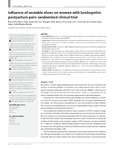Mostrar o rexistro simple do ítem
Influence of Unstable Shoes on Women With Lumbopelvic Postpartum Pain: Randomized Clinical Trial
| dc.contributor.author | Díaz-Meco Conde, Raquel | |
| dc.contributor.author | Ruiz Ruiz, Beatriz | |
| dc.contributor.author | Rubio Alonso, Margarita | |
| dc.contributor.author | Calvo-Lobo, César | |
| dc.contributor.author | Labra, Carmen de | |
| dc.contributor.author | López-López, Daniel | |
| dc.contributor.author | Romero Morales, Carlos | |
| dc.date.accessioned | 2021-08-23T07:43:47Z | |
| dc.date.available | 2021-08-23T07:43:47Z | |
| dc.date.issued | 2021-07 | |
| dc.identifier.citation | Díaz-Meco Conde R, Ruiz Ruiz B, Rubio Alonso M, Calvo-Lobo C, de Labra C, López-López D, et al. Influence of unstable shoes on women with lumbopelvic postpartum pain: randomized clinical trial. Sao Pulo Med J. 2021;139(4):312-318. DOI: 10.1590/1516-3180.2020.0738.R1.0402021 | es_ES |
| dc.identifier.issn | 1516-3180 | |
| dc.identifier.uri | http://hdl.handle.net/2183/28272 | |
| dc.description.abstract | [Abstract] Background: Back pain is a normal symptom during pregnancy and is expected to become worse beyond the first three months after childbirth. Objectives: To determine the effectiveness of wearing unstable shoes instead of conventional shoes, regarding pain intensity, low back mobility and stability, among women with lumbopelvic pain (LPP) during the postpartum period. Design and setting: Prospective, single-blinded, randomized clinical trial conducted at a podiatry and physiotherapy clinical center. Methods: A nine-week program of wearing either unstable shoes (A) or conventional shoes (B) was implemented. The following outcomes were measured in three assessments: pain intensity, using a visual analogue scale (VAS); low-back mobility, using a modified Schober test; and stability, using a pressure platform. Results: The lateral stability speed, anterior stability speed and anterior center of pressure (COP) showed significant (P < 0.05) decreases in the unstable shoes group after nine weeks, in relation to the conventional group. Intra-group measurements showed significant differences (P < 0.05) in VAS between the second and third assessments and between the first and third assessments in both groups. Intra-group evaluations also showed statistically significant differences (P < 0.05) in the lateral stability speed and anterior stability speed. Conclusions: Unstable shoes were effective in decreasing the pain intensity at five and nine weeks in women with postpartum LPP. In addition, their use produced decreases in lateral stability speed, anterior stability speed and anterior COP at nine weeks. | es_ES |
| dc.language.iso | eng | es_ES |
| dc.publisher | Scielo | es_ES |
| dc.relation.uri | https://doi.org/10.1590/1516-3180.2020.0738.R1.0402021 | es_ES |
| dc.rights | Atribución 4.0 Internacional | es_ES |
| dc.rights.uri | http://creativecommons.org/licenses/by/4.0/ | * |
| dc.subject | Postpartum period | es_ES |
| dc.subject | Low back pain | es_ES |
| dc.subject | Shoes | es_ES |
| dc.subject | Pregnancy | es_ES |
| dc.title | Influence of Unstable Shoes on Women With Lumbopelvic Postpartum Pain: Randomized Clinical Trial | es_ES |
| dc.type | info:eu-repo/semantics/article | es_ES |
| dc.rights.access | info:eu-repo/semantics/openAccess | es_ES |
| UDC.journalTitle | Sao Paulo Medical Journal | es_ES |
| UDC.volume | 139 | es_ES |
| UDC.issue | 4 | es_ES |
| UDC.startPage | 312 | es_ES |
| UDC.endPage | 318 | es_ES |
| dc.identifier.doi | 10.1590/1516-3180.2020.0738.R1.0402021 |
Ficheiros no ítem
Este ítem aparece na(s) seguinte(s) colección(s)
-
GI-NEURO - Artigos [165]






